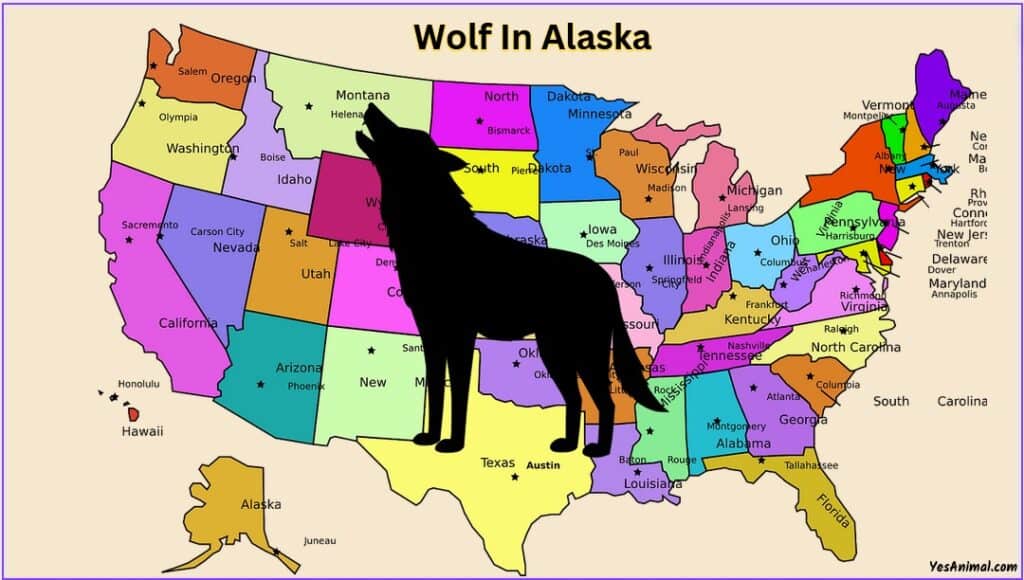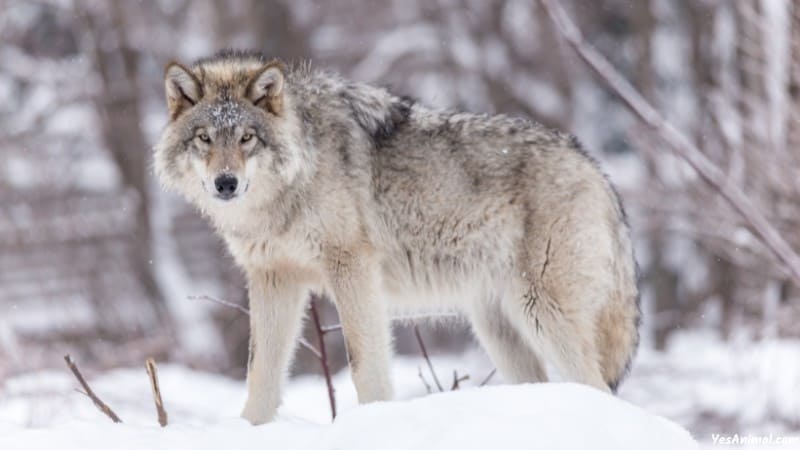Last Updated on April 15, 2024 by Amin Tawar

From polar bears to humpback whales, Alaska is home to a variety of terrestrial and marine life in the world. It is also the state with the highest population of Grizzly bears, Moose, Caribou, and wolves.
Yes! This beautiful state also has a large population of wolves, in fact, Alaska is the state with the largest number of wolves in the U.S.
While wolves generally avoid contact with humans, it is necessary to have a basic understanding of these magnificent creatures especially if you live in rural areas where wolves are known to inhabit.
Below I’ve explained all the things you need to know about the wolves in Alaska.
Are There Wolves in Alaska? How Many Wolves Are in Alaska?
Yes, there are wolves currently habiting the Alaskan forests and mountains. While these social animals are found throughout the state, their range includes about 85% of Alaska’s total area.
Alaska is currently home to about 7,000 to 11,000 wolves. Due to the availability of prey and lack of urbanization, wolves’ population in Alaska has never deteriorated like in the other states.
While wolves in Alaska have never been threatened and protected, it is still pertinent to track, manage and control the wolf population in the state.
What Is the Biggest Wolf in Alaska?
Alaska is home to 3 species of wolves: the gray wolf, the black wolf, and the interior wolf. Though these wolves differ in size and fur color most of their other characteristics stay the same. In addition, each of the wolf species’ role in their natural habitat is critical to its ecosystem’s stability.
Wolves reach adulthood at 1 year at which most of the male wolves in Alaska weigh between 80 to 115 pounds and females weigh lesser than males by at least 10 to 15 pounds.
Of the three species of wolves found in Alaska, the gray wolf is the largest among them all. And the largest individual wolf on record was a gray wolf weighing 176 pounds and 2 m in length when measured from nose to tail.
Are Wolves A Danger in Alaska?

No, Wolves in Alaska are not considered a significant danger to humans.
Due to their physical appearance, wolves are often misunderstood to be man-eating carnivores.
Wolf generally feeds on undulates like deer, moose, and elk including small mammals like rodents, rabbits, and beavers.
While wolves generally avoid human encounters and don’t pose a serious threat to humans, there may be exceptions to this when a wolf is trying to protect their young or kill.
There have been about 12 recorded wolf attacks of which only one was fatal. In addition, most of the attacks happen because of wolves’ loss of fear of humans.
To avoid this, people need to stop feeding wolves, keep pet foods outdoors, protect livestock, and maintain a safe distance when observing wolves in the wild. As with any wild animal, we need to be cautious and aware when in areas with wolf presence.
Also Check Our Guide On Wolves In US
Where Do Wolves Live in Alaska?
As wolves are very adaptable, they exist in a wide variety of habitats from the rainforests of the southeast panhandle to the arctic tundra. While wolves occupy all their historic range, they are currently not found in the center of urban areas.
It is important to note that wolf distribution depends a lot on the availability of prey, suitable habitat, and human population.
While most area of Alaska is habitable by wolves, the highest density of wolves population occurs in southeast Alaska which consequently has a high population of Sitka black-tailed deer that are predated by these carnivores.
Of the three species of wolves, Gray wolves are more common and are found throughout the state. Yukon wolf, also called interior wolf is a sub-species of gray wolf and as the name suggests, is found in the interior regions of Alaska. The black wolf is the rarest of the three and is mostly found in the southeast part of Alaska.
How Many Wolves Are Killed in Alaska?
The number of wolves killed varies year by year depending on a range of factors most important of which are population estimate and management goal.
As per the Alaska Department of Fish and Game, about 1200 wolves are killed each year in the state.
While most of the time, wolves are killed during hunting and trapping season as a sport, they may also be killed for management goals.
It’s worthwhile to note that Alaska is home to not one but many apex predators and these may compete with each other for prey. Some wolves are also killed to prevent prey or other wildlife decline and protect domestic animals.
Also Check Our Guide On Wolves In Arizona
Why Do Alaskans Not Eat Wolves?
As per state and federal laws, it is illegal to hunt, capture and kill wolves for commercial purposes.
Moreover, wolf meat is not a desirable or common source of food in Alaska. Additionally, as wolves also have cultural significance, most people avoid eating them as a source of food.
Some Indigenous communities native to Alaska do consume wolves as a source of food.
However, killings are tightly regulated, small scale and culturally significant activity that doesn’t represent these practices and attitudes towards wolves by a large section of people.
What Is the Famous Wolf in Alaska?
Known as “Romeo”, this black wolf that lived in the Mendenhall Valley near Juneau, gained widespread fame for his unusual behavior with people and dogs. Romeo was often playing with dogs, approaching people on roads, and exhibiting a level of friendliness that was very uncommon for a wild wolf.
However, people grew concerned due to its interaction with domestic animals, fearing that the wolf had become habituated to human habitats.
While Romeo was found dead in 2009, most likely killed by humans, his story lives on in books, documentaries, etc. highlighting the importance of coexisting with wild animals.
Can You Hunt & Own Wolf in Alaska?
Yes, you can hunt and own a wolf in Alaska. While it’s legal to hunt or kill a wolf, hunting and trapping of wolves is managed by the state of Alaska.
Additionally, many regulations and rules are set up to manage and maintain a sustainable population of wolves.
While owning a wolf or wolf-dog hybrid is legal as per the Alaska Department of Fish and Game in the state of Alaska, releasing, and breeding wolves is illegal and requires special permits.
As wolves are wild creatures and owning them may not just affect you but also the people living near you, it is important to be experienced and trained in managing these wild creatures. In addition to the basic state regulations, wolf owners need to conform to the local municipality’s regulations related to wolf ownership too.
Conclusion
And that was everything you need to know about the Wolf In Alaska. I hope this article was informative and your queries were answered.
Thank You For Reading!
Our Goto Source For This Guide